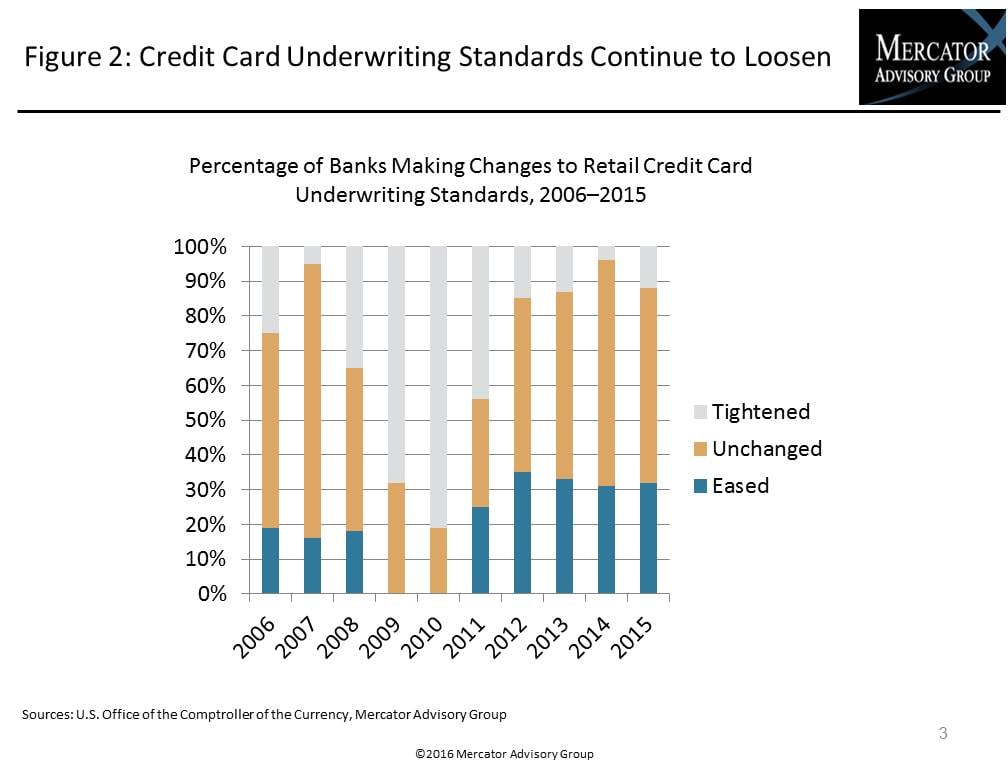Overview
The slow but steady climb that the U.S. consumer credit card industry has made back to prerecession performance levels will continue in 2016. Purchase volumes on general purpose credit cards will continue to increase, along with delinquency and charge-off rates, as issuers loosen their underwriting standards and consumers take on greater levels of debt. The massive investments made by issuers and merchants in chip card technology in 2014 and 2015 will bear significant fruit in 2016 as the penetration rates for EMV cards and payment terminals reach meaningful levels.
The coming year will mark a continuation of these long-standing trends and strategic initiatives. However, 2016 will also mark the breakthrough moment for at least one of the disruptive digital innovations that have been looming over the U.S. consumer credit card industry. Whether it’s the mass market adoption of third-party mobile wallets from Apple, Google, and Samsung or the launch of a merchant-friendly mobile payments alternative or the wholesale digitization of the credit card acquisition process, it seems likely that this year will see the promise of at least one of these innovations actually realized.
Mercator Advisory Group’s latest research note, 2016 Outlook In-Depth: U.S. Consumer Credit Cards examines the continuing trends and emerging innovations that are expected to shape the profitability and strategic plans of U.S. credit card issuers in 2016.
“Despite steady growth metrics and a surprisingly successful chip card transition, issuers cannot take their foot of the gas in 2016. Payment security is not going away and the ongoing digitization of the credit card, both in acquisition and utilization, will give issuers plenty to work on in the coming year,” comments Alex Johnson, Senior Analyst, Credit Advisory Service at Mercator Advisory Group and the author of the research note.
This document contains 11 pages and 5 exhibits.
Companies mentioned in this research note include: Apple, Chase, Discover, Google, Lending Club, NerdWallet, OnDeck Capital, Prosper, Samsung, Starbucks, Target, Wallaby, and Walmart.
One of the exhibits included in this report:

Highlights of the research note include:
- Projections for the U.S. consumer credit card market’s primary profitability and risk metrics
- Predictions for the U.S. consumer credit card market based on new competitive dynamics, changing consumer behaviors, and emerging technologies observed by Mercator Advisory Group
- Recommendations for how U.S. credit card issuers and merchants should respond to the trends identified in this research note
Book a Meeting with the Author
Related content
Honor All Cards: The U.S. Credit Card Model Takes a Hit
The Honor All Cards principle—that any merchant with a Visa and/or Mastercard sticker in the window accepts all card products on those networks—could be undermined by a recent sett...
2026 Credit Payments Trends
The U.S. credit card market is healthy and strong, but performances among banks diverge along size lines. Large issuers have been able to better curate their customers through acqu...
Young Borrowers: Riskier Than Ever...and the Future of Credit Cards
The future of credit cards rests with younger consumers, in the 18-to-29 age range, and not with their parents and grandparents. Here’s the rub, though: These consumers are a much ...
Make informed decisions in a digital financial world